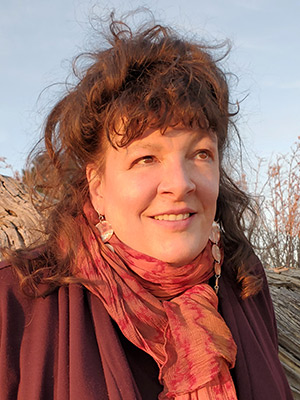Angela Babby
Angela Babby is an award-winning artist who has revived and combined ancient techniques into a unique form of art: enameled glass mosaic. Unlike other glass artists, she expands upon traditional stained glass techniques with kiln-fired enamel details in her mosaic art. Her “glass-on-glass” approach combines her love of painting with the luminosity and saturation of color uniquely expressed in glass. A hallmark of her work is how the subject matter strikes the viewer with its emotional content.
An enrolled member of the Oglala Lakota Sioux Tribe, Babby’s Lakota ancestry influences her work and the mysterious nature of glass. She received a Bachelor of Fine Arts degree in painting in 1990 from Montana State University, Billings, MT. As a painter, she worked primarily in watercolors and acrylics. Painters who inspired her style include American Indian artists Fritz Scholder, Oscar Howe, and T. C. Cannon, and art nouveau painters Gustav Klimt and Alphonse Mucha.
Babby first became interested in glass as a medium in a sculpture class in college. The lack of color in metal and wood challenged her to find a way to bring color into her designs. Her good friend suggested stained glass and introduced her to the medium and Bullseye stained glass made in Portland, Oregon. She ultimately went to work at the Bullseye Factory, learning a myriad of glass fabrication techniques and solidifying her love of this magical medium.
Babby moved in 1995 to Phoenix, Arizona, where she continued her first love of painting by starting a decorative painting business. Her work included murals, decorative finishes, and creating mosaics for her clients. When she applied to and was accepted into the Heard Museum Indian Art Market, she was shocked to find people just like her at the show. A few were relatives. Participating in the Heard and other Native American art markets eventually led to her transition from paint to glass as her primary medium. It also led to her struggle and ultimate success to get the medium recognized by the art market community.
Babby sees her work as solitary, “Just me and the glass having a conversation,” as she put it. While her only instruction in glass art came while she worked at Bullseye Glass, she was influenced and inspired by significant glass artists such as Louis Comfort Tiffany, Antoni Gaudi, Gustav Klimt, and Dale Chihuly.
The process to create her work is complex and labor-intensive. Babby starts with sketches of the subject and the design of the composition. Once this stage is complete, she transfers the design to cardboard templates that she transfers onto glass, chosen for its color and pattern.
The glass pieces are cut and ground to fit together. She paints some of the pieces with powdered enamel mixed with a medium to become liquid. As it dries, the enamel becomes a powder again. The piece is quite fragile at this stage until it is fired in a kiln to over 1,000 degrees Fahrenheit, creating a glass-on-glass work of art that resembles a painting with great depth of color. The fired pieces are brought together with the other design pieces, adhered onto tile board, and mortar is applied.
Babby’s work is arresting for its artistry and use of color. Many of her works are notable for their content which often includes a political dimension related to the story of the Oglala Lakota. She did not grow up on her reservation and did not become interested and steeped in the history of her people until she became an adult.
In 2009 she was commissioned to create an artwork for the Red Cloud High School located in Pine Ridge, SD, where her relatives were schooled and boarded, baptized and buried. Completing this vital work for Lakota school children was a turning point in her career; she has been very involved with her people ever since. She feels lucky to have been led back to her people through her art and is profoundly honored to be welcomed. Last summer, Angela taught her art form to Native American high school students at the Oscar Howe Summer Art Institute at the University of South Dakota, Vermillion, SD. She most recently won Best of Show at the Native POP: People of the Plains in Rapid City, SD.
Showing her works at Indian Art Markets connected Babby to her heritage. Her father, Wyman Babby, wrote a history in the Library of Congress in Washington DC that traces the genealogy and history of her family’s ancestors. Learning her relationship to the Oglala and to first peoples as a whole has influenced her work as her portraiture is imbued with emotion, bringing to life her subjects.
